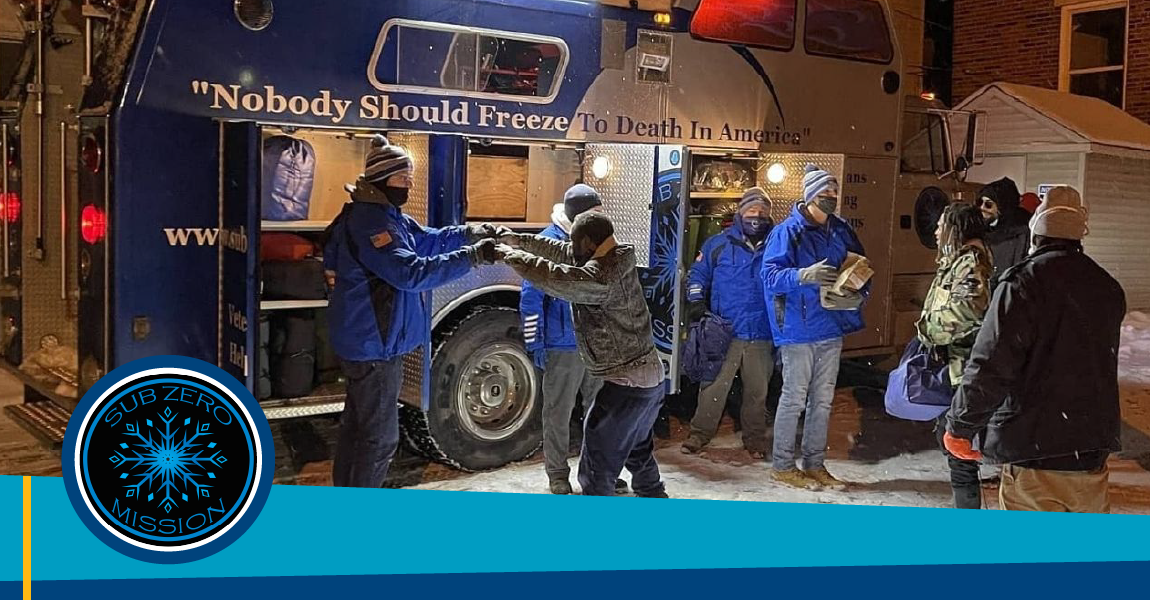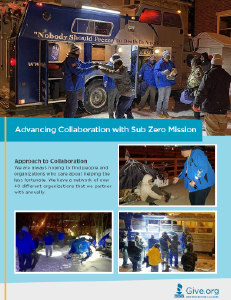
Advancing Collaboration with the Sub Zero Mission
About the Organization
The Sub Zero Mission collects coats, boots, hats, gloves, and sleeping bags (our "Stay Alive 5") in warmer months to be distributed in the winter directly to homeless people who do not make it into shelters. We help every person we find, but we are looking for veterans among the homeless. We work to put veterans back into contact with programs specialized to get them off of the streets permanently.
Featured Guest
Al "Sarge" Raddatz, CEO
Sub Zero Mission
Approach to Collaboration
We are always hoping to find people and organizations who care about helping the less fortunate. We have a network of over 40 different organizations that we partner with annually.
Application of the 9 Considerations for Collaboration
Build Trust
Trust is the basis for effective collaboration. Good governance, solid financial management and reporting, and truthful and transparent communications demonstrate trust. Trustworthiness can lead to better results and increased willingness to collaborate.
To establish trust, our organization is very transparent. At first, when we meet an organization, donor, or another interested party, we will always invite them to come and meet at our HQ so that they can see exactly what we do and how. We also have several methods to provide the information remotely. We are proud to be accredited through BBB WGA and, in the interest of transparency, we provide all of our financial and administrative information on our website www.SubZeroMission.org.
When seeking to collaborate, outline organizational expectations over an established period. Long-range planning can also help identify potential stresses on existing programs.
To ensure harmony between our vision and our collaborators, we seek to understand what our collaborators focus on the most. Given our mission of distributing warming items, we welcome our partners to participate. We do our best to fulfill what we promise, show up on time, and provide transportation. We also often offer our resources (conference rooms, volunteers, etc.) for our partners' missions.
Know the expectations of both the project and collaborative participants. Communication is key; regular intervals for discussion and a willingness to adjust are essential for a project to succeed.
Take Stock
We examine our organizational strengths and weaknesses and are willing to share this information with our collaborators. We are constantly reviewing what we do and how. We often seek feedback from the groups we work with; we use standard problem management methodologies such as fishbone diagrams and Five Whys questions to determine how we can improve.
Start Small
We start small by collaborating with short-term, inexpensive projects that allow the organization to build confidence and willingness to trust. We are open to collaboration
on projects big and small.
We set timetables and identify goals and responsibilities among staff. If partners aren't pulling their weight, we reassess, adjust or consider moving on.
Everybody that we work with has my direct number. We also have a well-established chain of command to escalate issues. Finally, we have a standing weekly meeting for our operational team to discuss issues that we run into when we perform our daytime and nightly missions.
Take a Portfolio Approach
We've established several promising collaborations with potential for new value. We've learned to prioritize these projects based on the assets and deficiencies of each partner until we identify the best match for our organization's values and goals.
Consider Non-Traditional PartnersWe work with many non-traditional companies to promote us internally and arrange warming item drives, whereas other companies may prefer to raise funds with us. Value can be found with corporations, startups, social networks, or other non-profits outside our usual realm of expertise.
Keep Your Donors Apprised of Your Collaborations
Collaborative projects may generate new fundraising, and funders may want to support the efforts of charities working together.
We regularly communicate our information via several channels of social media. We have an online "blog" on our website with events and partner information monthly. As CEO, I write an annual report that will often describe our partnerships.
Future Collaborations
I would love to get out of the business of raising money and holding donation drives for our items. I would like to help get people off the street permanently by making the products ourselves, but have them made by the homeless, for the homeless. To do this, I would need a network of partners. We would need funding to help pay the homeless employees. We would need companies that would be interested in donating materials to be turned into coats or gloves. We would need a mental healthcare provider and, likely, a chemical dependency treatment provider. We would also need to build on our network of housing providers.
In the end, it is not enough to hand a homeless person a sleeping bag and then drive away. The practical answer is to provide real empowerment. The cure for homelessness is a home; the keys to a home come through a job. Jobs are maintained and kept through energy, a clear mind, and a healthy lifestyle. I would like to see my team become part of a plan to re-empower the homeless and help them re-engage as members of society.
Conclusion
There is never enough collaboration. Tell your story, listen to your partners, and try to find the "win/win." Use your strengths to help your partners and allow them to help you by using theirs.
This article was composed by Rachel Romana Liu.



